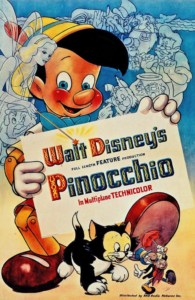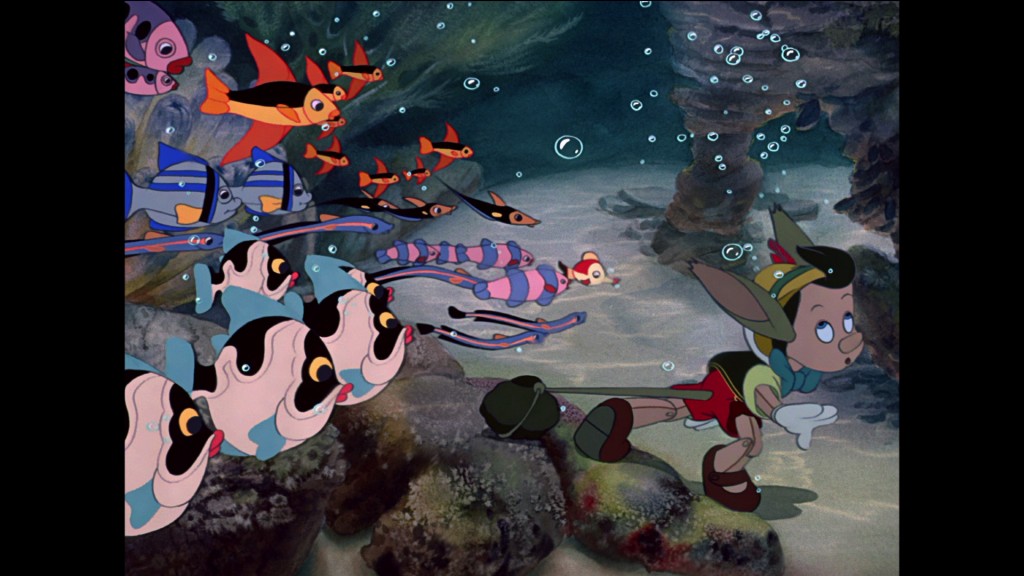Pinocchio (1940)
“Now, remember, Pinocchio: be a good boy — and always let your conscience be your guide.”
|
Synopsis: |
|
Genres, Themes, Actors, and Directors:
Response to Peary’s Review: Pinocchio — like Snow White — is yet another astonishingly bold Disney adaptation of a “children’s tale” which is simply far too scary for the littlest of audience members. Peary drolly states that the “film has a lot of visuals that could scare a young child (but that’s okay)” — italics mine (!!). Countless fans have shared anecdotes about the most frightening scenes they recall from their own childhoods, with some citing the culminating sea-battle with Monstro the whale (“fabulously animated” with meticulous care; Peary refers to it as “absolutely terrifying”), and many others — including myself — noting that the most personally terrifying scenes were those in which the little boys at “Pleasure Island” are gradually turned into braying donkeys, to be sent off to work in the salt mines or at carnivals. Ouch. (And — minor spoiler alert — there’s no final resolution to this dilemma, by the way; as far as audience members know, the boys’ metamorphoses are permanent.) Indeed, Pinocchio unapologetically presents the world as the big, bad place it often is, full of temptations and evil, in which it’s really each man — or child — for himself. Pinocchio’s father, while kind-hearted, is presented as utterly clueless, from the moment he sends his “newly born son” out into the world to go to school (why not walk him there on the first day, for goodness sake??? he’s the ultimate ANTI-helicopter-parent), to the final episode of the film, in which we see him mysteriously trapped in a whale, essentially in need of rescuing by Pinocchio himself, rather than the other way around. Meanwhile, it’s a good thing Pinocchio has more reliable “adults” to count on — though both the Blue Fairy (animated via rotoscoping, she truly is “exceptional” looking) and Jiminy Cricket (ukelele-playing Cliff Edwards is “perfect” as his voice) are equally “hands off” at critical moments. Ultimately (spoilers here again), when Pinocchio is granted the wish he’s longed for during his entire short existence, he’s proven he truly deserves it. Redeeming Qualities and Moments:
Must See? Categories
(Listed in 1001 Movies You Must See Before You Die) Links: |




One thought on “Pinocchio (1940)”
A no-brainer must ~ esp. since this is one of those marvelous occasions in which a classic animated film can be appreciated by adults just as much as kids (if not more so).
On this revisit, I discovered I had practically no memory of ‘Pinocchio’ at all. In most cases of this kind of ‘amnesia’, that usually means that, for me, there’s just not much to remember. But, in this case, it’s just that it really had been *that* long since I’d seen the film. If it weren’t for the fact that I’m on-board for this project, I most likely wouldn’t be revisiting films such as this. I did get the lesson of the film when I was young, and – not having kids of my own – well…you understand.
So it was surprising to me that, seeing ‘Pinocchio’ again, I found much to admire and be impressed by. Overall, I find it a very clever film that doesn’t condescend to its audience. It has an important message about morality and honesty, and the film carries that message through with charm, warmth and appropriate weight.
It’s true: ‘Pinocchio’ does show life “as the big, bad place it often is” ~which, of course, is necessary for working through the film’s theme. However, here – as would be the case years later with ‘Mary Poppins’ – a spoonful of sugar helps the medicine go down. Even though the ‘Honest John’ character is slimy, the song he is given – ‘Hi-Diddle-Dee-Dee’ – is a charming delight. And even though ‘Honest John’ sells Pinocchio to a sideshow owner, the song Pinocchio performs in his act – ‘I’ve Got No Strings On Me’ – is (for me, anyway) one of the film’s (many) highlights: Pinocchio’s antics with the wooden dolls who do have strings are quite entertaining.
It should also be noted that much of the dialogue in the script is refreshingly sharp, witty and easily geared to the adults watching with their kids. A fave of mine in this regard is one of Jiminy Cricket’s lines when he’s about to leave Pinocchio to his life in the sideshow. Of course, Jiminy is supposed to be Pinocchio’s guide and conscience; still, he lets out with, “Well, I guess he won’t need me anymore. What does an actor want with a conscience anyway?”
Each of the film’s sections has been thoroughly thought-out and it shows. I particularly like the allegorical aspect of Pleasure Island. (Except that, of course, in real life boys with a penchant for the fast life of ‘Pleasure Island’ would not be terrified to discover that they are jackasses who have been turned out to ‘the salt mines’.)
~btw: in that sequence, the character Lampwick is given a great line when, while playing pool, he attempts to get rid of Jiminy Cricket – or, at least, get him off the pool table: “Screwball in the side pocket.”
I also like the fact that, even though ‘Pinocchio’ is in a sense a musical, it doesn’t feel compelled to be a musical throughout. The second half of the film doesn’t really have songs at all. A smart move.
[Side note: I don’t know that I find Geppetto “utterly clueless” as much as utterly introverted – a man whose understanding of life is dictated by more-or-less inanimate objects. It makes sense to me that he would not know to walk his ‘son’ to school the first day. As well, I don’t find his appearance in the whale to be all that mysterious. To me, it seems that Geppetto realized his ‘son’ had been ‘robbed’ from him, and he took those dearest to him (Figaro and Cleo) and went on a boat to find the one who kept him most connected to life.]
‘Pinocchio’ would indeed often be frightening for kids. However, it seems to me that the film takes it for granted that – at the time of its release – watching such a film was a guaranteed, shared experience: that parents would be watching with their children, and would later talk them through the scarier/heavier stuff. At any rate, that’s the kind of thing I would have expected my parents to do with me. On some level, after all, most kids would essentially know it’s just a movie.